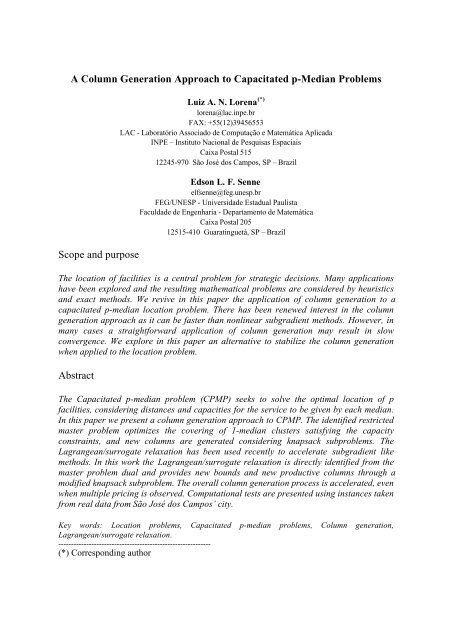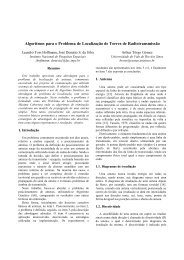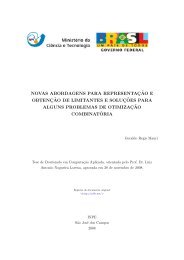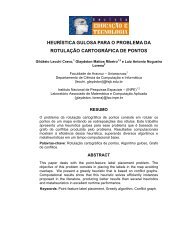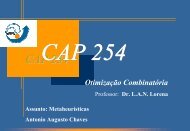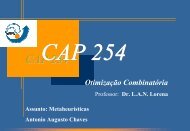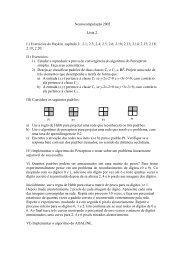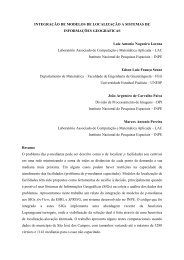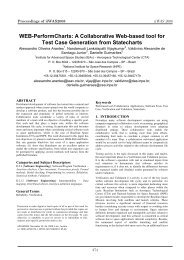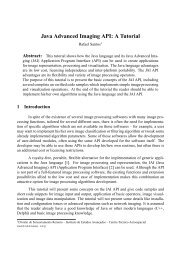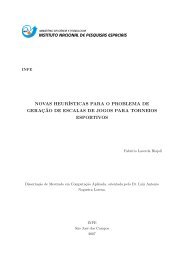A Column Generation Approach to Capacitated p-Median Problems ...
A Column Generation Approach to Capacitated p-Median Problems ...
A Column Generation Approach to Capacitated p-Median Problems ...
Create successful ePaper yourself
Turn your PDF publications into a flip-book with our unique Google optimized e-Paper software.
[x ij ] n×n is the allocation matrix, with x ij =1 if entity i is allocated <strong>to</strong> median j, and x ij =0,otherwise; x jj = 1 if median j is selected and x jj = 0, otherwise.Constraints (2) and (3) impose that each entity is allocated <strong>to</strong> only one median. Constraint(4) imposes that a <strong>to</strong>tal median capacity must be respected, and (5) provides the integerconditions.We assume equal capacities <strong>to</strong> simplify the alternative set covering formulation <strong>to</strong> be givenin the sequel.The CPMP problem can also be modeled as the following set partitioning problem with acardinality constraint (SPP):(SPP)v(SPP)= Minm∑k = 1m∑c kxsubject <strong>to</strong> A = 1(6)k=1m∑k=1xkkxkk=x ∈{0,1} ,kp(7)whereS = S , S ,..., S }, is a set of subsets of N;{1 2 mA = [a ik] nxm , is a matrix withandck⎛= Min⎜∑d1i∈Sk1⎝ j∈Skijaik=⎞⎟, considering⎠⎧⎨⎩1, if i ∈Sk, satisfying ∑ qiaik≤ Q ;0, otherwiseS = { ∈ S ka = 1}1ki .iki∈NThis is the formulation found in Minoux [28]. The same formulation can be obtained fromthe problem P by applying the Dantzig-Wolfe decomposition. For each subset1S k , theopen median is decided when the column cost ck is calculated, and so the columns of SPPimplicitly consider the constraints set (4) in P. Constraints (1) and (2) are conserved and
Note that for λ = π, the same n knapsack problems of equation (8) come out in the solutionof L 1 P π (for the Lagrangean case, where t = 1) and Sub π P. Then, if the multipliers πi(i =1,...,n) of problem SCP are given <strong>to</strong> problem L 1 P π , the corresponding Lagrangean problemcan be used <strong>to</strong> generate columns and also <strong>to</strong> give a lower bound <strong>to</strong> P and SCP.The Lagrangean/surrogate is integrated <strong>to</strong> the column generation process transferring themultipliers πi(i = 1,...,n) of problem SCP <strong>to</strong> the problemMax v(L t P π ), and returning thet≥0corresponding columns. If the new columns continue <strong>to</strong> satisfy expression (11), then theycan be added <strong>to</strong> the pool of candidate columns. The resulting effect is an acceleration of theconvergence, even when multiple columns are added <strong>to</strong> the pool at each iteration of theprocess.The Lagrangean/surrogate is a valid lower bound <strong>to</strong> the column generation process. Inparticular it is better than the Lagrangean bound (t = 1) and can be useful <strong>to</strong> defineconvergence settings <strong>to</strong> the restricted master. Figure 1 shows a typical behavior of dualbounds integrated <strong>to</strong> the column generation.Figure 1. Typical computational behavior of dual bounds4. The algorithmsThe parameter t is the differential in the Lagrangean/surrogate relaxation. Varying thisparameter can reproduce the usual Lagrangean relaxation (t is fixed <strong>to</strong> 1) and betterLagrangean bounds (t is identified using the dicho<strong>to</strong>mous search procedure SH described in
End_while.NCOLS is set <strong>to</strong> 1000 in computational tests described in the next section. To preventinfeasibilities, a high cost dummy column formed of ones is also included on the initial set.In order <strong>to</strong> remove columns we have conserved in the process only the 3000 columnspresenting the smaller reduced costs.5. Computational experimentsThe algorithms described in section 4 are coded in C and the computational tests weremade on a Sun Ultra30 workstation.The set of instances comprising real data were collected using the GeographicalInformation System ArcView (ESRI [12]), and report the central area of São José dosCampos city. Six instances (100x10), (200x15), (300x25), (300x30), (402x30) and(402x40) are created, containing 100, 200, 300 and 402 nodes. Each point is located on ablock, which presents a demand node and is also a possible place <strong>to</strong> locate medians.Demand was estimated considering the number of houses (apartments) at each block. Anempty block received value 1. Capacities are then estimated as∑⎡C = ⎢⎢numberdemands ⎤⎥ , where α was set equal <strong>to</strong> 0.9 or 0.8. These instances areof medians × α⎥available at http://www.lac.inpe.br/~lorena/instancias.html, and Figures 2 and 3 show,respectively, the set of points for a instance of 100 nodes and the corresponding solution for10 medians.
Figure 2: Instance of 100 nodes (central area of São José dos Campos)Figure 3: Instance of 100 nodes (solution for 10 medians)Tables 1 and 2 report the computational results obtained by the CG(t) and CG(1)algorithms. The primal-dual gaps compare the best known feasible solutions of (P),obtained using the location-allocation heuristics reported in [24] (see also Table 3), and therespective dual and linear programming bounds (v(LtPπ) and v(SCP)).Table 1 – Results for CG(t)Table 2 – Results for CG(1)Observe from Tables 1 and 2 that algorithm CG(t) is faster and able <strong>to</strong> generate fewerproductive columns than CG(1). This result can be very interesting for large scaleinstances.These results are even better when compared with the Lagrangean/surrogate relaxationassociated <strong>to</strong> a subgradient method. Table 3 reports the results obtained by the LSLSH(t)heuristic, described in [24], <strong>to</strong> the same set of instances. Heuristic LSLSH(t) is aLagrangean/surrogate heuristic combined with a traditional subgradient method andlocation-allocation primal heuristics.Table 3 – Results for LSLSH(t)
It is interesting <strong>to</strong> investigate whether the columns generated by CG(t) are productive whenthe number of columns is limited at the master problem. Table 4 presents the results for thetime-consuming instance sjc4a. The number of columns at the master problem is set <strong>to</strong>values on the interval [2800, 3500].Table 4 – Restricting the number of columns at the master problemNote that as the number of fixed columns decreases the CG(t) algorithm remainsoperational finding the respective solutions of Table 1. Algorithm CG(1) presented adegraded effect when the number of columns decreases, especially for 2900 and 2800columns. The gaps increase and the results of Table 2 are not reproduced. All thecomputational tests reported have made with an iteration limit of 300.The computational tests proceeded with a large-scale instance. The Pcb3038 instance in theTSPLIB, compiled by Reinelt [33], was considered for the tests. The capacities wereestimated as∑⎡ demands ⎤C = ⎢⎥ and the number of columns at the master⎢numberof medians × 0.8⎥problem was fixed <strong>to</strong> 20000. These instances are also available athttp://www.lac.inpe.br/~lorena/instancias.html. The results presented in Tables 5 and 6confirm that CG(t) is able <strong>to</strong> generate better quality columns than CG(1). We can alsoobserve that when the number of required medians decreases the problems are moredifficult and time consuming. The CG(t) expends almost half the computational time ofCG(1), which seems <strong>to</strong> be an important consideration for such large scale instances.Table 5. Computational results for CG(t) on Pcb3038 instances
Table 6. Computational results for CG(1) on Pcb3038 instances6. ConclusionsThis paper presented column generation approaches for a CPMP. The approaches integratethe traditional column generation <strong>to</strong> the Lagrangean/surrogate relaxation context,identifying new productive columns and accelerating the computational process.The computational results show that the Lagrangean/surrogate sub-problem generates asmall number of productive columns and the restricted master is also manageable with asmall number of columns.The Lagrangean/surrogate lower bounds can be useful <strong>to</strong> branch-and-price trees and arecurrently being explored in this context.Acknowledgments: The authors acknowledge Fundação de Amparo à Pesquisa do Estado de SãoPaulo - FAPESP (proc. 99/06954-7) and Conselho Nacional de Desenvolvimen<strong>to</strong> Científico eTecnológico - CNPq (processes 302408/88-6 and 300837/89-5) for partial financial researchsupport. We also acknowledge the very useful suggestions and comments of two anonymousreferees.References1. Barnhart, C.; Johnson, E.L.; Nemhauser, G.L.; Savelsbergh, M.W.P.; Vance, P.H. Branchand-Price:<strong>Column</strong> <strong>Generation</strong> for Solving Huge Integer Programs. Operations Research1998; 46: 316-329.2. Beasley, J.E. Or-library: Distributing test problems by electronic mail. Journal OperationalResearch Society 1990; 41: 1069-1072.3. Bramel, J,; Simchi-Levi, D. A location based heuristic for general routing problems.Operations Research 1995; 43: 649-660.
4. Carvalho, J.M.V. Exact Solution of Bin-Packing <strong>Problems</strong> Using <strong>Column</strong> <strong>Generation</strong> andBranch-and-Bound, Universidade do Minho, Departamen<strong>to</strong> Produção e Sistemas, WorkingPaper, 1996.5. Cooper, L. Location-allocation problems. Operations Research 1963; 11: 331-343.6. Dantzig, G.B.; Wolfe, P. Decomposition principle for linear programs. Operations Research1960; 8: 101-111.7. Day, P.R.; Ryan, D.M. Flight Attendant Rostering for Short-Haul Airline Operations.Operations Research 1997; 45: 649-661.8. Desrochers, M.; Desrosiers, J.; Solomon, M. A New Optimization Algorithm for theVehicle Routing Problem with Time Windows. Operations Research 1992; 40: 342-354.9. Desrochers, M.; Soumis, F. A <strong>Column</strong> <strong>Generation</strong> <strong>Approach</strong> <strong>to</strong> the Urban Transit CrewScheduling Problem. Transportation Science 1989; 23: 1-13.10. du Merle, O.; Goffin, J.L.; Vial, J.P. On Improvements <strong>to</strong> the Analytic Centre Cutting PlaneMethod. Computational Optimization and Applications 1998; 11: 37-52.11. du Merle, O.; Villeneuve, D.; Desrosiers, J.; Hansen, P. Stabilized column generation.Discrete Mathematics 1999; 194: 229-237.12. ESRI Environmental Systems Research Institute, Inc. Avenue Cus<strong>to</strong>mization andApplication Development for ArcView, 1996.13. França, P.M.; Sosa, N.M.; Pureza, V. An adaptive tabu search algorithm for the capacitatedp-median problem. International Transactions in Operations Research 1999; 6: 665-678.14. Gilmore, P.C.; Gomory, R.E. A linear programming approach <strong>to</strong> the cutting s<strong>to</strong>ck problem.Operations Research 1961; 9: 849-859.15. Gilmore, P.C.; Gomory, R.E. A linear programming approach <strong>to</strong> the cutting s<strong>to</strong>ck problem -part ii. Operations Research 1963; 11: 863-888.16. ILOG CPLEX 6.5. ILOG Inc. Cplex Division, 1999.17. Kelley, J.E. The Cutting Plane Method for Solving Convex Programs. Journal of the SIAM1960; 8: 703-712.18. Klein, K.; Aronson, J.E. Optimal clustering: a model and method. Naval Research Logistics1991; 38, 447-461.19. Koskosidis, Y.A.; Powell, W.R. Clustering algorithms for consolidation of costumes ordersin<strong>to</strong> vehicle shipments. Transportation Research B 1992; 26: 365-379.20. Lorena, L. A. N.; Furtado, J. C. Constructive Genetic Algorithm for Clustering <strong>Problems</strong>.Evolutionary Computation 2001; 9(3): 309-327.21. Lorena, L.A.N.; Lopes, F.B. A surrogate heuristic for set covering problems. EuropeanJournal of Operational Research 1994; 79: 138-150.22. Lorena, L.A.N.; Narciso, M.G. Relaxation heuristics for a generalized assignment problem.European Journal of Operational Research 1996; 91: 600-610.23. Lorena, L.A.N.; Senne, E.L.F. Improving traditional subgradient scheme for Lagrangeanrelaxation: an application <strong>to</strong> location problems. International Journal of MathematicalAlgorithms 1999; 1: 133-151.24. Lorena, L.A.N.; Senne, E.L.F. Local search heuristics for capacitated p-median problems.Networks and Spatial Economics 2002; <strong>to</strong> appear.25. Maniezzo, V.; Mingozzi, A.; Baldaci, R. A bionomic approach <strong>to</strong> the capacitated p-medianproblem. Journal of Heuristics 1998; 4: 263-280.26. Marsten, R.M.; Hogan, W.; Blankenship, J. The Boxstep method for large-scaleoptimization. Operations Research 1975; 23: 389-405.27. Martello, S.; Toth, P. Knapsack problems: Algorithms and computer implementations, JohnWiley & Sons, 1990.28. Minoux, M. A Class of Combina<strong>to</strong>rial <strong>Problems</strong> with Polynomially Solvable Large ScaleSet Covering/Set Partitioning Relaxations. RAIRO 1987; 21 (2): 105–136.
29. Mulvey, J.M.; Beck, M.P. Solving capacitated clustering problems. European Journal ofOperational Research 1984; 18: 339-348.30. Narciso, M.G.; Lorena, L.A.N. Lagrangean/surrogate relaxation for generalized assignmentproblems. European Journal of Operational Research 1999; 114: 165-177.31. Neame, P.J. Nonsmooth Dual Methods in Integer Programming Phd Thesis - Department ofMathematics and Statistics, The University of Melbourne, 1999.32. Osman, I.H.; Chris<strong>to</strong>fides, N. <strong>Capacitated</strong> clustering problems by hybrid simulatedannealing and tabu search. International Transactions in Operational Research 1994; 1: 317-336.33. Reinelt, G. The traveling salesman problem: computational solutions for TSP applications.Lecture Notes in Computer Science 840, Springer Verlag, Berlin, 1994.34. Senne, E.L.F.; Lorena, L.A.N. Lagrangean/Surrogate Heuristics for p-<strong>Median</strong> <strong>Problems</strong>. InComputing Tools for Modeling, Optimization and Simulation: Interfaces in ComputerScience and Operations Research, M. Laguna and J.L. Gonzalez-Velarde (Eds.), KluwerAcademic Publishers, 2000. p. 115-130.35. Vance, P. Crew scheduling, cutting s<strong>to</strong>ck and column generation: solving huge integerprograms. PhD thesis, Georgia Institute of Technology, 1993.36. Vance, P.H.; Barnhart, C.; Johnson, E.L.; Nemhauser, G.L. Solving Binary Cutting S<strong>to</strong>ck<strong>Problems</strong> by <strong>Column</strong> <strong>Generation</strong> and Branch-and-Bound. Computational Optimization andApplications 1994; 3: 111-130.
VitaeLuiz An<strong>to</strong>nio Nogueira Lorena is a senior researcher of the Applied Mathematics and ComputationLabora<strong>to</strong>ry (LAC) at INPE (Brazilian Space Research Institute), Brazil. He received a Dr. Degree inSystem Engineering and Computation (1985) from COPPE at Federal University of Rio de Janeiro,Brazil. His main research activities are on combina<strong>to</strong>rial optimization applications with particularemphasis in heuristics. He has published in European Journal of Operational Research, Journal ofthe Operational Research Society, Evolutionary Computation, Geoinformatica, IEEE TCAD,International Journal of Industrial Engineering, and International Journal of MathematicalAlgorithms.Edson Luiz França Senne is a computer science professor in the Mathematics Department at SãoPaulo State University, Campus of Guaratinguetá. He received the Doc<strong>to</strong>rate in AppliedComputation in 1987 from INPE – Brazilian Space Research Institute. His research interest includescombina<strong>to</strong>rial optimization applications, decision support systems and geographical informationsystems. He has published in European Journal of Operational Research, Journal of IntelligentSystems and International Journal of Mathematical Algorithms.
v(L t P π )400020000-20000 10 20 30 40 50 60Iterations-4000-6000-8000-10000LagrangeanLagrangean/surrogateFigure 1. Typical computational behavior of dual bounds
Figure 2: Instance of 100 nodes (central area of São José dos Campos)
Figure 3: Instance of 100 nodes (solution for 10 medians)
Instance n p Bestv(SCP)Bestv(L t P p )Gap-CG<strong>Column</strong>sGeneratedTime (s)sjc1 100 10 17149.57 17149.56 0.806 3297 10.80sjc2 200 15 33232.59 33231.89 0.487 9277 114.20sjc3a 300 25 45244.70 45243.83 0.263 16480 351.51sjc3b 300 30 40634.36 40634.34 0.002 17011 316.40sjc4a 402 30 61850.64 61850.20 0.241 30931 1125.08sjc4b 402 40 52403.89 52403.89 0.451 28643 729.01Table 1 – Results for CG(t)The columns contain:Instance = the instance identification;n and p = number of nodes and the required number of medians;Best v(SCP) = the best value obtained <strong>to</strong> (SCP);Best v(L t P π ) = the best (dual) lower bound obtained using the Lagrangean/surrogate relaxation;Gap-CG = 100 * (Best known feasible solution – Best v(SCP))/(Best known feasible solution);<strong>Column</strong>s Generated = number of columns generated;Time = <strong>to</strong>tal computational time (in seconds).
Instance n p Bestv(SCP)Bestv(L 1 P p )Gap-CG<strong>Column</strong>sGeneratedTime (s)sjc1 100 10 16889.02 16893.91 2.313 4287 14.05sjc2 200 15 33232.59 33231.78 0.487 12167 151.59sjc3a 300 25 45240.03 45239.55 0.273 22499 553.76sjc3b 300 30 40635.90 40635.89 0.002 21196 382.24sjc4a 402 30 61816.25 61815.36 0.241 37240 1522.31sjc4b 402 40 52369.48 52369.26 0.517 34769 894.25Table 2 – Results for CG(1)The columns contain:Instance = the instance identification;n and p = number of nodes and the required number of medians;Best v(SCP) = the best value obtained <strong>to</strong> (SCP);Best v(L 1 P π ) = the best (dual) lower bound obtained using the Lagrangean relaxation;Gap-CG = 100 * (Best known feasible solution – Best v(SCP))/(Best known feasible solution);<strong>Column</strong>s Generated = number of columns generated;Time = <strong>to</strong>tal computational time (in seconds).
Instance n p Best known Best Gap-LS Timefeasible solution v(L t Pl)sjc1 100 10 17288.99 17252.12 0.213 68.62sjc2 200 15 33395.38 33223.66 0.514 2083.37sjc3a 300 25 45364.30 45313.43 0.112 2604.92sjc3b 300 30 40635.90 40634.91 0.002 867.68sjc4a 402 30 62000.23 61842.49 0.254 27717.11sjc4b 402 40 52641.79 52396.54 0.466 4649.47Table 3 – Results for LSLSH(t)The columns contains:Best known feasible solution = solution <strong>to</strong> P obtained using location-allocation heuristics [24];n and p = number of nodes and the required number of medians;Best v(L t Pλ) = the best (dual) lower bound obtained using the Lagrangean/surrogate relaxation andsubgradient method;Gap-LS = 100 * (Best known feasible solution – Best v(L t Pλ ) )/(Best known feasible solution).Time = <strong>to</strong>tal computational time (in seconds).
Numberof<strong>Column</strong>siterations<strong>Column</strong>sGeneratedBestv(SCP)CG(t)Gap-CGBestv(L t P p ) Gap-LS Time3500 101 30149 61850.64 0.241 61849.90 0.011 1169.963300 102 30544 61850.64 0.241 61850.64 0.013 1097.563100 113 32678 61849.29 0.243 61849.26 0.011 1175.253000 106 30931 61850.64 0.241 61850.20 0.013 1112.292900 96 29156 61850.64 0.241 61850.63 0.013 1079.852800 111 32429 61850.64 0.241 61850.23 0.012 1115.98Numberof<strong>Column</strong>siterations<strong>Column</strong>sGeneratedBestv(SCP)CG(1)Gap-CGBestv(L 1 P p ) Gap-LS Time3500 120 39334 61665.98 0.539 61666.28 - 0.284 1672.673300 126 38273 61844.14 0.251 61843.67 0.010 1578.463100 134 40982 61667.16 0.537 61667.16 - 0.283 1638.283000 119 37240 61816.25 0.296 61815.36 - 0.043 1525.352900 300 82790 62108.74 - 0.175 54691.75 - 11.562 1855.602800 300 90360 62483.74 - 0.779 44403.46 - 28.129 1832.64Table 4 – Restricting the number of columns at the master problemThe columns contain:Number of columns = fixed number of columns at the master problem.<strong>Column</strong>s Generated = number of columns generated;Best v(SCP) = the best value obtained <strong>to</strong> (SCP);Gap-CG = 100 * (Best known feasible solution – Best v(SCP))/(Best known feasible solution);Best v(L t P π ) = the best (dual) lower bound obtained using the Lagrangean/surrogate relaxation;Best v(L 1 P π ) = the best (dual) lower bound obtained using the Lagrangean relaxation;Gap-LS = 100 * (Best known feasible solution – Best v(L t Pλ))/(Best known feasible solution);Time = <strong>to</strong>tal computational time (in seconds).
p iterations <strong>Column</strong>s Best Best TimeGenerated v(SCP) v(L t P p )1000 33 87438 83012.98 83231.58 20210.25900 36 92578 90131.62 90239.65 25306.54800 38 98445 98483.26 98530.99 33844.27700 42 106365 108657.04 108685.59 46705.53600 48 116623 122020.69 122020.66 59593.02Table 5. Computational results for CG(t) on Pcb3038 instancesThe columns contain:<strong>Column</strong>s Generated = number of columns generated;Best v(SCP) = the best value obtained <strong>to</strong> (SCP);Best v(L t P π ) = the best (dual) lower bound obtained using the Lagrangean/surrogate relaxation;Time = <strong>to</strong>tal computational time (in seconds).
P iterations <strong>Column</strong>s Best Best TimeGenerated v(SCP) v(L 1 P p )1000 83 234140 82876.12 83063.37 38888.77900 85 243657 89950.80 90009.72 45456.65800 96 266708 98309.25 98378.65 64686.50700 103 283213 108658.92 108684.88 90724.47600 111 311157 121960.16 121980.34 123581.41Table 6. Computational results for CG(1) on Pcb3038 instancesThe columns contain:<strong>Column</strong>s Generated = number of columns generated;Best v(SCP) = the best value obtained <strong>to</strong> (SCP);Best v(L 1 P π ) = the best (dual) lower bound obtained using the Lagrangean relaxation;Time = <strong>to</strong>tal computational time (in seconds).


